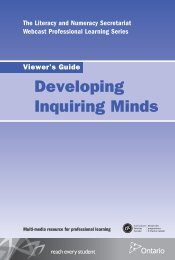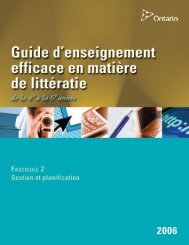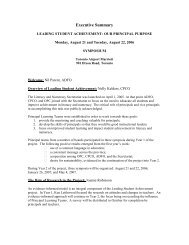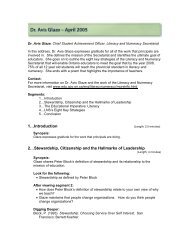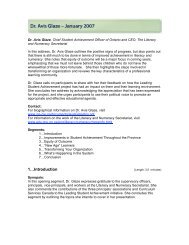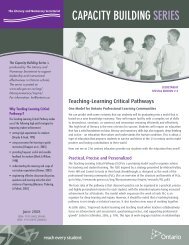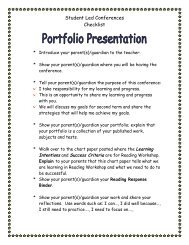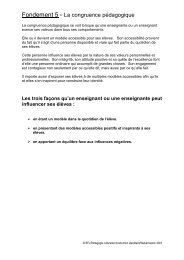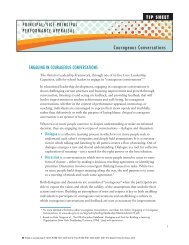Precision Teaching in the Primary Classroom Viewer's Guide
Precision Teaching in the Primary Classroom Viewer's Guide
Precision Teaching in the Primary Classroom Viewer's Guide
- No tags were found...
Create successful ePaper yourself
Turn your PDF publications into a flip-book with our unique Google optimized e-Paper software.
The Literacy and Numeracy Secretariat<br />
Webcast Professional Learn<strong>in</strong>g Series<br />
Viewer’s <strong>Guide</strong><br />
<strong>Precision</strong> <strong>Teach<strong>in</strong>g</strong><br />
<strong>in</strong> <strong>the</strong> <strong>Primary</strong> <strong>Classroom</strong><br />
Multi-media resource for professional learn<strong>in</strong>g
On this DVD you will f<strong>in</strong>d a Pr<strong>in</strong>t and Video Resources folder which conta<strong>in</strong>s<br />
WMV files for PowerPo<strong>in</strong>t presentations and this Viewer’s <strong>Guide</strong> <strong>in</strong> PDF.<br />
To order <strong>the</strong> multi-media package <strong>Precision</strong> <strong>Teach<strong>in</strong>g</strong> <strong>in</strong> <strong>the</strong> <strong>Primary</strong><br />
<strong>Classroom</strong>:<br />
Contact ServiceOntario<br />
416-326-5300 or 1-800-668-9938<br />
http://www.publications.serviceontario.ca/ecom<br />
The webcast segments and related resources are also accessible onl<strong>in</strong>e at<br />
http://www.curriculum.org/secretariat/precision/<strong>in</strong>dex.shtml.<br />
This resource may be copied for not-for-profit educational purposes.<br />
Funded by <strong>the</strong> Literacy and Numeracy Secretariat, M<strong>in</strong>istry of Education.
Table of Contents<br />
Overview . . . . . . . . . . . . . . . . . . . . . . . . . . . . . . . . . . . . . . . . . . . . . . . . . . . . 2<br />
Webcast Segments: . . . . . . . . . . . . . . . . . . . . . . . . . . . . . . . . . . . . . . . . . . . . 4<br />
• Introduction . . . . . . . . . . . . . . . . . . . . . . . . . . . . . . . . . . . . . . . . . . 4<br />
• Word Sort . . . . . . . . . . . . . . . . . . . . . . . . . . . . . . . . . . . . . . . . . . . . 5<br />
– Differentiated Word Sort . . . . . . . . . . . . . . . . . . . . . . . . . . . . . . . 5<br />
– Teacher Debrief of <strong>the</strong> Word Sort . . . . . . . . . . . . . . . . . . . . . . . . 6<br />
– Mak<strong>in</strong>g <strong>the</strong> Learn<strong>in</strong>g Visible . . . . . . . . . . . . . . . . . . . . . . . . . . . . 6<br />
• Inference Game . . . . . . . . . . . . . . . . . . . . . . . . . . . . . . . . . . . . . . . . 7<br />
• Writ<strong>in</strong>g . . . . . . . . . . . . . . . . . . . . . . . . . . . . . . . . . . . . . . . . . . . . . . 7<br />
– Success Criteria and Exemplars . . . . . . . . . . . . . . . . . . . . . . . . . 7<br />
– Shared Writ<strong>in</strong>g . . . . . . . . . . . . . . . . . . . . . . . . . . . . . . . . . . . . . . . 8<br />
– Writ<strong>in</strong>g Conference: Peers . . . . . . . . . . . . . . . . . . . . . . . . . . . . . . 8<br />
– Writ<strong>in</strong>g Conferences: Student-Teacher . . . . . . . . . . . . . . . . . . . . . 9<br />
• Learn<strong>in</strong>g Centres . . . . . . . . . . . . . . . . . . . . . . . . . . . . . . . . . . . . . . . 9<br />
• <strong>Guide</strong>d Read<strong>in</strong>g . . . . . . . . . . . . . . . . . . . . . . . . . . . . . . . . . . . . . . . 10<br />
– <strong>Guide</strong>d Read<strong>in</strong>g Debrief . . . . . . . . . . . . . . . . . . . . . . . . . . . . . . 11<br />
• Student Self-Assessment . . . . . . . . . . . . . . . . . . . . . . . . . . . . . . . . 11<br />
• <strong>Classroom</strong> Tour . . . . . . . . . . . . . . . . . . . . . . . . . . . . . . . . . . . . . . . 12<br />
General View<strong>in</strong>g . . . . . . . . . . . . . . . . . . . . . . . . . . . . . . . . . . . . . . . . . . . . . 13<br />
References . . . . . . . . . . . . . . . . . . . . . . . . . . . . . . . . . . . . . . . . . . . . . . . . . 14<br />
Technical Instructions<br />
How to Access Pr<strong>in</strong>t and Video Resources . . . . . . . . . . . . . . . . . . . . . . . . . 15<br />
How to Save <strong>the</strong> Video Files to Your Computer . . . . . . . . . . . . . . . . . . . . . 16<br />
How to Insert Video Clips (WMV files) <strong>in</strong>to a PowerPo<strong>in</strong>t Presentation . . . . 17
Overview<br />
Provid<strong>in</strong>g precise and personalized <strong>in</strong>struction that meets <strong>the</strong> diverse needs of<br />
students with<strong>in</strong> a classroom is complex. It is <strong>in</strong>formed by many factors <strong>in</strong>clud<strong>in</strong>g<br />
ongo<strong>in</strong>g assessment, feedback, teacher knowledge of how her/his students<br />
learn best and <strong>the</strong> pedagogical and content competencies of <strong>the</strong> teacher.<br />
In this Grade 3 classroom, <strong>the</strong> learn<strong>in</strong>g<br />
environment is structured to allow<br />
students to self-assess, reflect and<br />
set personal learn<strong>in</strong>g goals. Time for<br />
<strong>in</strong>teraction and talk helps students<br />
develop <strong>the</strong>ir understand<strong>in</strong>g of <strong>the</strong>mselves<br />
as learners. They become more<br />
<strong>in</strong>dependent and metacognitively<br />
aware.<br />
Students beg<strong>in</strong> to understand <strong>the</strong><br />
value and relevance of what <strong>the</strong>y are<br />
learn<strong>in</strong>g. They clearly understand and<br />
can articulate <strong>the</strong> learn<strong>in</strong>g <strong>in</strong>tentions.<br />
They monitor <strong>the</strong>ir progress and know<br />
how to access help as needed. By participat<strong>in</strong>g<br />
<strong>in</strong> <strong>the</strong> assessment process <strong>the</strong>y<br />
learn how to receive, give and act on<br />
feedback.<br />
John Hattie <strong>in</strong> Visible Learn<strong>in</strong>g<br />
states that successful learn<strong>in</strong>g is<br />
<strong>the</strong> result of:<br />
• <strong>the</strong> worthwhileness and clarity<br />
of <strong>the</strong> learn<strong>in</strong>g <strong>in</strong>tentions<br />
• <strong>the</strong> success criteria<br />
• <strong>the</strong> power of us<strong>in</strong>g multiple and<br />
appropriate teach<strong>in</strong>g strategies<br />
• ongo<strong>in</strong>g assessment with an<br />
emphasis on feedback<br />
• see<strong>in</strong>g learn<strong>in</strong>g and teach<strong>in</strong>g<br />
from <strong>the</strong> students’ perspective<br />
(Hattie, 2009, p. 199)<br />
In this classroom, you will see a teacher<br />
who believes that all students can learn.<br />
The student-teacher relationship is strong and <strong>the</strong> culture of <strong>the</strong> classroom<br />
is respectful, positive and <strong>in</strong>clusive. Ongo<strong>in</strong>g assessment is woven throughout<br />
<strong>the</strong> day and students are actively <strong>in</strong>cluded <strong>in</strong> <strong>the</strong> assessment process. Toge<strong>the</strong>r<br />
with <strong>the</strong> teacher, <strong>the</strong>y reflect on <strong>the</strong>ir learn<strong>in</strong>g and determ<strong>in</strong>e next steps.<br />
This learn<strong>in</strong>g community is one that welcomes risk-tak<strong>in</strong>g and errors as a<br />
way of learn<strong>in</strong>g. Every student has a voice and <strong>the</strong>y all feel that <strong>the</strong>y are<br />
valued members of <strong>the</strong> classroom.<br />
2
Students and teacher collaboratively create success criteria and exemplars<br />
to guide <strong>the</strong> achievement of <strong>the</strong>ir learn<strong>in</strong>g goals. Dur<strong>in</strong>g <strong>the</strong> gradual release<br />
of responsibility, students work <strong>in</strong> a variety of group<strong>in</strong>gs that support<br />
differentiated <strong>in</strong>struction. Students learn from each o<strong>the</strong>r, each br<strong>in</strong>g<strong>in</strong>g<br />
<strong>the</strong>ir strengths to <strong>the</strong> task. Work<strong>in</strong>g <strong>in</strong> teams helps students develop <strong>the</strong>ir<br />
collaborative skills. They learn to value o<strong>the</strong>rs’ ideas, question respectfully<br />
and build new knowledge toge<strong>the</strong>r. These are skills students will f<strong>in</strong>d useful<br />
throughout <strong>the</strong>ir lives <strong>in</strong> school and beyond.<br />
The literacy block flows seamlessly, with each strand of <strong>the</strong> language curriculum<br />
<strong>in</strong>tegrated. Language and word study are woven throughout <strong>the</strong> block <strong>in</strong> <strong>the</strong><br />
context of what students are study<strong>in</strong>g. Through <strong>the</strong> gradual release model,<br />
students are explicitly taught what <strong>the</strong>y need to know and be able to do <strong>in</strong><br />
order to achieve <strong>the</strong>ir learn<strong>in</strong>g goals. They have many opportunities to practise<br />
newly taught skills and concepts with vary<strong>in</strong>g degrees of support until <strong>the</strong>y<br />
are ready to work <strong>in</strong>dependently.<br />
Students ga<strong>in</strong> confidence <strong>in</strong> <strong>the</strong>mselves as learners. They know how to use <strong>the</strong><br />
co-constructed tools posted around <strong>the</strong> classroom. Rout<strong>in</strong>es are established<br />
that allow students easy access to materials and ways of organiz<strong>in</strong>g, monitor<strong>in</strong>g<br />
and shar<strong>in</strong>g <strong>the</strong>ir work. The classroom is <strong>the</strong>ir work environment and students<br />
are very familiar with its organization, management and resources.<br />
Throughout <strong>the</strong> day, teachers and students are engaged <strong>in</strong> conversations<br />
about learn<strong>in</strong>g. They give, receive and act on descriptive feedback that moves<br />
<strong>the</strong>ir learn<strong>in</strong>g forward. In this dynamic learn<strong>in</strong>g environment, all members<br />
are actively learn<strong>in</strong>g from, with and on behalf of each o<strong>the</strong>r.<br />
3
WEBCAST SEGMENTS<br />
Introduction<br />
In this Grade 3 classroom, students are actively <strong>in</strong>volved <strong>in</strong> <strong>the</strong>ir learn<strong>in</strong>g.<br />
Every element of <strong>the</strong> literacy block is seamlessly connected. Students participate<br />
fully <strong>in</strong> self-assessment and <strong>in</strong> sett<strong>in</strong>g learn<strong>in</strong>g goals and success criteria.<br />
They are not afraid to take a risk and are very reflective about <strong>the</strong>ir learn<strong>in</strong>g<br />
and next steps.<br />
Based on ongo<strong>in</strong>g assessment, <strong>the</strong> teacher’s <strong>in</strong>struction is precise and <strong>in</strong>tentional<br />
<strong>in</strong> order to meet <strong>the</strong> needs of all students. Through <strong>the</strong> gradual release<br />
of responsibility, time is provided to practise skills and strategies with vary<strong>in</strong>g<br />
degrees of support until students are able to work <strong>in</strong>dependently. Time for<br />
talk, <strong>in</strong>teraction and reflection are woven throughout <strong>the</strong> literacy block to<br />
support students’ learn<strong>in</strong>g, metacognition and <strong>in</strong>dependence. The teacher is<br />
fully present dur<strong>in</strong>g <strong>the</strong> teach<strong>in</strong>g-learn<strong>in</strong>g process, observ<strong>in</strong>g <strong>the</strong> impact of<br />
her teach<strong>in</strong>g on student learn<strong>in</strong>g and ready to adjust as needed to meet <strong>the</strong><br />
needs of all students.<br />
• How are you able to engage <strong>in</strong> <strong>in</strong>tentional, precision teach<strong>in</strong>g and still<br />
rema<strong>in</strong> flexible enough to be able to take advantage of “just right”<br />
teachable moments<br />
• Ongo<strong>in</strong>g assessment for learn<strong>in</strong>g is essential. How do you ga<strong>the</strong>r, monitor,<br />
act upon and share assessment <strong>in</strong>formation with your students <strong>in</strong> a<br />
way that improves <strong>the</strong>ir learn<strong>in</strong>g and achievement<br />
Lorna Earl describes assessment for learn<strong>in</strong>g as follows:<br />
“In <strong>the</strong> classroom, we foster student growth by clearly def<strong>in</strong><strong>in</strong>g learn<strong>in</strong>g goals,<br />
scaffold<strong>in</strong>g learn<strong>in</strong>g experiences, provid<strong>in</strong>g varied opportunities for practice, and<br />
giv<strong>in</strong>g mean<strong>in</strong>gful feedback.”<br />
She goes on to describe assessment for learn<strong>in</strong>g <strong>in</strong> <strong>the</strong> follow<strong>in</strong>g terms:<br />
“When <strong>the</strong>y are do<strong>in</strong>g Assessment for Learn<strong>in</strong>g, teachers collect a wide range of<br />
data so that <strong>the</strong>y can modify <strong>the</strong> learn<strong>in</strong>g work for <strong>the</strong>ir students. They craft<br />
assessment tasks that open a w<strong>in</strong>dow on what students know and can do<br />
already and use <strong>the</strong> <strong>in</strong>sights that come from <strong>the</strong> process to design <strong>the</strong> next steps<br />
<strong>in</strong> <strong>in</strong>struction. To do this, teachers use observation, worksheets, question<strong>in</strong>g <strong>in</strong><br />
class, student-teacher conferences, or whatever mechanism is likely to give <strong>the</strong>m<br />
4
<strong>in</strong>formation that will be useful for <strong>the</strong>ir plann<strong>in</strong>g and teach<strong>in</strong>g. Mark<strong>in</strong>g is not<br />
designed to make comparative judgments among <strong>the</strong> students but to highlight …<br />
[students’] strengths and weaknesses and provide <strong>the</strong>m with feedback that will<br />
fur<strong>the</strong>r <strong>the</strong>ir learn<strong>in</strong>g … [Teachers] use <strong>the</strong>ir personal knowledge of <strong>the</strong> students<br />
and <strong>the</strong>ir understand<strong>in</strong>g of <strong>the</strong> context of <strong>the</strong> assessment and <strong>the</strong> curriculum<br />
targets to identify particular learn<strong>in</strong>g needs. Assessment for Learn<strong>in</strong>g happens<br />
<strong>in</strong> <strong>the</strong> middle of learn<strong>in</strong>g, often more than once, ra<strong>the</strong>r than at <strong>the</strong> end. It is<br />
<strong>in</strong>teractive, with teachers provid<strong>in</strong>g assistance as part of <strong>the</strong> assessment. It helps<br />
teachers provide <strong>the</strong> feedback to scaffold next steps.”<br />
(Ontario M<strong>in</strong>istry of Education, 2010)<br />
Word Sort<br />
Differentiated Word Sort<br />
In this segment, you will see students <strong>in</strong>volved <strong>in</strong> a word sort that is openended<br />
enough to engage every learner. The goal is to help students develop<br />
vocabulary that describes <strong>the</strong> characteristics of people and animals <strong>the</strong>y meet<br />
<strong>in</strong> <strong>the</strong>ir read<strong>in</strong>g. The task also develops students’ understand<strong>in</strong>g of how root<br />
words, prefixes and suffixes work. This knowledge will help students read and<br />
write <strong>in</strong>dependently. They draw on <strong>the</strong>ir schema and prior experiences and<br />
build on <strong>the</strong> ideas of o<strong>the</strong>rs as <strong>the</strong>y collaborate to solve <strong>the</strong> problem at hand.<br />
• Dur<strong>in</strong>g <strong>the</strong> word sort, students negotiated with group members as<br />
<strong>the</strong>y built <strong>the</strong>ir understand<strong>in</strong>g of <strong>the</strong> relationship between <strong>the</strong> words.<br />
The teacher played an essential role dur<strong>in</strong>g this work and th<strong>in</strong>k time.<br />
What did you notice about <strong>the</strong> strategies she used to push <strong>the</strong> learn<strong>in</strong>g<br />
forward for her students<br />
• Which of <strong>the</strong>se strategies might you use with your students to support<br />
<strong>the</strong>ir learn<strong>in</strong>g<br />
• What plann<strong>in</strong>g needed to happen prior to this lesson to set students up<br />
for success<br />
“The language of <strong>the</strong> classroom, especially <strong>the</strong> <strong>in</strong>cidental talk that goes on while children<br />
are work<strong>in</strong>g, gives strong messages to children about <strong>the</strong>ir ability.”<br />
(Clarke, 2009, p. 55)<br />
5
“In vocabulary development … <strong>the</strong> teacher’s role is twofold: (1) to teach students<br />
(directly and <strong>in</strong>directly) how words look and sound, what <strong>the</strong>y mean and how <strong>the</strong>y are<br />
used, and (2) to teach and model <strong>the</strong> process of learn<strong>in</strong>g new words so that students<br />
may become <strong>in</strong>creas<strong>in</strong>gly <strong>in</strong>dependent <strong>in</strong> <strong>the</strong>ir vocabulary development.”<br />
(Ontario M<strong>in</strong>istry of Education, 2003, p. 8.11)<br />
Teacher Debrief of <strong>the</strong> Word Sort<br />
This word sort lesson was planned <strong>in</strong>tentionally to meet <strong>the</strong> needs of students<br />
as reflected <strong>in</strong> <strong>the</strong>ir writ<strong>in</strong>g and read<strong>in</strong>g. The task is open-ended and differentiated<br />
to be <strong>in</strong>clusive of all students.<br />
• What strategies did you notice this teacher us<strong>in</strong>g <strong>in</strong> order to differentiate<br />
<strong>the</strong> task<br />
• How might you ensure that word study happens <strong>in</strong> <strong>the</strong> context of what<br />
students are learn<strong>in</strong>g and that it is precise and personal enough to<br />
meet <strong>the</strong> diverse needs of <strong>the</strong> students <strong>in</strong> your classroom<br />
• What strategies might you use to facilitate <strong>the</strong> word study knowledge<br />
be<strong>in</strong>g transferred to student’s writ<strong>in</strong>g<br />
Four components of comprehensive vocabulary <strong>in</strong>struction:<br />
• foster<strong>in</strong>g word consciousness<br />
• teach<strong>in</strong>g <strong>in</strong>dividual words<br />
• teach<strong>in</strong>g strategies for learn<strong>in</strong>g words <strong>in</strong>dependently<br />
• present<strong>in</strong>g frequent/extensive/varied opportunities for <strong>in</strong>dependent read<strong>in</strong>g<br />
(Baumann & Kame’enui, 2004)<br />
Mak<strong>in</strong>g <strong>the</strong> Learn<strong>in</strong>g Visible<br />
Dur<strong>in</strong>g whole-group shar<strong>in</strong>g, students share new learn<strong>in</strong>g and make <strong>the</strong>ir<br />
th<strong>in</strong>k<strong>in</strong>g visible to each o<strong>the</strong>r. Each student clarifies <strong>the</strong>ir th<strong>in</strong>k<strong>in</strong>g and builds<br />
on <strong>the</strong> ideas of o<strong>the</strong>rs. As <strong>the</strong>y reconstruct how <strong>the</strong>y solved <strong>the</strong> problem,<br />
students learn to articulate <strong>the</strong>ir th<strong>in</strong>k<strong>in</strong>g.<br />
Know<strong>in</strong>g how words work is a transferable skill that will serve students<br />
throughout <strong>the</strong>ir school life and beyond.<br />
• Listen<strong>in</strong>g to <strong>in</strong>formation, mak<strong>in</strong>g mean<strong>in</strong>g and <strong>the</strong>n remember<strong>in</strong>g<br />
significant <strong>in</strong>formation is not an easy task for children. How might<br />
you help students benefit from oral shar<strong>in</strong>g sessions<br />
6
• Dur<strong>in</strong>g this shar<strong>in</strong>g session, students are encouraged to reflect on <strong>the</strong>ir<br />
learn<strong>in</strong>g and expla<strong>in</strong> <strong>the</strong>ir th<strong>in</strong>k<strong>in</strong>g. The teacher values students’ th<strong>in</strong>k<strong>in</strong>g<br />
and encourages <strong>the</strong>m to th<strong>in</strong>k deeply about <strong>the</strong>ir work. Students are<br />
develop<strong>in</strong>g <strong>the</strong>ir metacognitive awareness.<br />
• What strategies might you use to help students become more aware of<br />
<strong>the</strong>mselves as learners<br />
Inference Game<br />
In this clip, students are actively engaged <strong>in</strong> a game that re<strong>in</strong>forces <strong>the</strong>ir<br />
understand<strong>in</strong>g of <strong>the</strong> term “<strong>in</strong>ference.” The teacher pulls unfamiliar objects<br />
from a mystery bag and <strong>the</strong> students are challenged to <strong>in</strong>fer <strong>the</strong> function of<br />
each based on <strong>the</strong> “tool’s clues.” As <strong>in</strong>ferences are made, students provide a<br />
rationale for <strong>the</strong>ir th<strong>in</strong>k<strong>in</strong>g. Infus<strong>in</strong>g active games <strong>in</strong>to <strong>the</strong> teach<strong>in</strong>g-learn<strong>in</strong>g<br />
process is an effective way to engage students <strong>in</strong> practis<strong>in</strong>g a newly taught<br />
skill or strategy.<br />
• What do you th<strong>in</strong>k are <strong>the</strong> benefits to students and to teachers of this<br />
approach to guided practice<br />
• How might you modify this game to support your students <strong>in</strong> <strong>the</strong> content<br />
area <strong>the</strong>y are currently study<strong>in</strong>g<br />
Writ<strong>in</strong>g<br />
Success Criteria and Exemplars<br />
Students are learn<strong>in</strong>g how to write about <strong>the</strong> <strong>in</strong>ferences <strong>the</strong>y draw <strong>in</strong> relation<br />
to <strong>the</strong> characters <strong>in</strong> <strong>the</strong> texts <strong>the</strong>y are read<strong>in</strong>g. They have collaboratively<br />
created learn<strong>in</strong>g goals, success criteria and exemplars to guide <strong>the</strong>ir writ<strong>in</strong>g.<br />
These learn<strong>in</strong>g tools are posted <strong>in</strong> <strong>the</strong> classroom for students to refer to<br />
dur<strong>in</strong>g <strong>the</strong>ir writ<strong>in</strong>g. Before <strong>the</strong>y work on <strong>the</strong>ir <strong>in</strong>dividual writ<strong>in</strong>g, <strong>the</strong>y will<br />
have many opportunities to write with support from <strong>the</strong>ir peers and teacher.<br />
• Exemplars are helpful <strong>in</strong> clarify<strong>in</strong>g for students exactly what is expected<br />
of <strong>the</strong>m <strong>in</strong> <strong>the</strong>ir work. How would you encourage students to use <strong>the</strong><br />
exemplars dur<strong>in</strong>g <strong>the</strong>ir writ<strong>in</strong>g as part of <strong>the</strong>ir self-assessment<br />
• How might you use exemplars <strong>in</strong> science or social studies<br />
• What caution might you need to consider when us<strong>in</strong>g exemplars with<br />
students<br />
7
Shared Writ<strong>in</strong>g<br />
Students are apply<strong>in</strong>g <strong>the</strong>ir newly learned skill of draw<strong>in</strong>g <strong>in</strong>ferences. They<br />
are writ<strong>in</strong>g a character trait description of <strong>the</strong> animals <strong>in</strong> a fable <strong>the</strong>y have<br />
recently read. As students decide on <strong>the</strong> characteristic to describe, <strong>the</strong>y are<br />
required to give evidence from <strong>the</strong> text or <strong>the</strong>ir schema to support <strong>the</strong>ir<br />
ideas. The teacher models <strong>the</strong> th<strong>in</strong>k<strong>in</strong>g <strong>in</strong>volved <strong>in</strong> select<strong>in</strong>g <strong>the</strong> appropriate<br />
adjectives and asks prob<strong>in</strong>g questions to push students’ th<strong>in</strong>k<strong>in</strong>g deeper.<br />
Students are referred back to <strong>the</strong> success criteria for guidance. The teacher<br />
models how success criteria must be flexible <strong>in</strong> order to adapt to new<br />
th<strong>in</strong>k<strong>in</strong>g as <strong>the</strong> writ<strong>in</strong>g evolves. Students reflect, self-assess and decide<br />
on next steps.<br />
• What strategies does <strong>the</strong> teacher use to lead students to become more<br />
reflective writers<br />
• What evidence of assessment do you notice <strong>in</strong> this clip<br />
• What important behaviours is this teacher modell<strong>in</strong>g Which of <strong>the</strong>se<br />
behaviours might you focus on with your students and why<br />
• How do you <strong>in</strong>volve your students <strong>in</strong> self-assessment and make <strong>the</strong>m<br />
aware of <strong>the</strong> benefits of ongo<strong>in</strong>g self-assessment<br />
Writ<strong>in</strong>g Conference: Peers<br />
Students have co-created success criteria and exemplars of effective pieces of<br />
writ<strong>in</strong>g that <strong>in</strong>cluded <strong>the</strong> reader’s th<strong>in</strong>k<strong>in</strong>g beh<strong>in</strong>d <strong>the</strong>ir <strong>in</strong>ferences. With <strong>the</strong>se<br />
tools to guide <strong>the</strong>ir conferences, students meet <strong>in</strong> pairs to give descriptive<br />
feedback to each o<strong>the</strong>r about <strong>the</strong>ir writ<strong>in</strong>g. Their thoughtful and respectful<br />
responses reflect a clear understand<strong>in</strong>g of <strong>the</strong> success criteria and <strong>the</strong> purpose<br />
of <strong>the</strong> conference.<br />
• What are <strong>the</strong> benefits to students and to <strong>the</strong> teacher of a peer writ<strong>in</strong>g<br />
conference<br />
• How might you guide <strong>the</strong>se students <strong>in</strong> prepar<strong>in</strong>g for <strong>the</strong>ir next writ<strong>in</strong>g<br />
conference<br />
• How might you use a clip such as this one with students to debrief how<br />
to give effective feedback<br />
8
Writ<strong>in</strong>g Conferences: Student-Teacher<br />
Dur<strong>in</strong>g <strong>the</strong> writ<strong>in</strong>g block, <strong>the</strong> teacher meets with students to check for understand<strong>in</strong>g<br />
and to provide differentiated support to move <strong>the</strong>ir learn<strong>in</strong>g forward.<br />
Part of <strong>the</strong> dialogue is devoted to develop<strong>in</strong>g <strong>the</strong> student’s understand<strong>in</strong>g of<br />
himself/herself as a writer. The teacher offers a choice of strategies <strong>the</strong> writer<br />
might consider try<strong>in</strong>g and debriefs with students what he/she perceives to be<br />
<strong>the</strong>ir needs. Students monitor <strong>the</strong>ir progress s<strong>in</strong>ce <strong>the</strong> last conference and<br />
help to determ<strong>in</strong>e next steps. Conversations are respectful and are focused<br />
on improv<strong>in</strong>g <strong>the</strong> student’s writ<strong>in</strong>g.<br />
• What did you notice about <strong>the</strong> teacher’s strategies that you might try<br />
with your students<br />
• What did you notice about <strong>the</strong> students’ behaviour dur<strong>in</strong>g <strong>the</strong> conference<br />
that reflected essential prior learn<strong>in</strong>g or experiences How might this<br />
knowledge of important prior learn<strong>in</strong>g impact on your <strong>in</strong>structional<br />
decisions<br />
“Learners need <strong>in</strong>formation and guidance <strong>in</strong> order to plan next steps <strong>in</strong> <strong>the</strong>ir learn<strong>in</strong>g.<br />
Teachers should: p<strong>in</strong>po<strong>in</strong>t <strong>the</strong> learner’s strengths and advise on how to develop <strong>the</strong>m;<br />
be clear and constructive about any weaknesses and how <strong>the</strong>y might be addressed;<br />
provide opportunities for learners to improve upon <strong>the</strong>ir work.”<br />
(Assessment Reform Group, 2002, p. 2)<br />
Learn<strong>in</strong>g Centres<br />
The class ga<strong>the</strong>rs around <strong>the</strong> organizational chart to review <strong>the</strong>ir commitments<br />
dur<strong>in</strong>g learn<strong>in</strong>g centres time. Dur<strong>in</strong>g this block, students <strong>in</strong>dependently apply<br />
and practise previously taught skills and strategies. Some of <strong>the</strong> tasks are<br />
mandatory and o<strong>the</strong>rs are free choice. While students are engaged <strong>in</strong> a variety<br />
of open-ended tasks, <strong>the</strong> teacher is free to assess <strong>the</strong>ir progress, offer support<br />
to small groups or <strong>in</strong>dividuals and plan for next steps to push <strong>the</strong> learn<strong>in</strong>g<br />
forward for all students.<br />
• What do you see as <strong>the</strong> greatest benefit of learn<strong>in</strong>g centres<br />
• In your op<strong>in</strong>ion, what might be <strong>the</strong> greatest challenge to implement<strong>in</strong>g<br />
learn<strong>in</strong>g centres<br />
• How might you address <strong>the</strong> challenge and build on <strong>the</strong> benefits of this<br />
approach to <strong>in</strong>dependent practice<br />
9
• How will you know if all students are benefit<strong>in</strong>g from this approach<br />
• How might you support students who are hav<strong>in</strong>g difficulty manag<strong>in</strong>g<br />
this type of learn<strong>in</strong>g<br />
• What twenty-first century skills are be<strong>in</strong>g addressed through a learn<strong>in</strong>g<br />
centres approach<br />
<strong>Guide</strong>d Read<strong>in</strong>g<br />
Students practise previously taught read<strong>in</strong>g strategies as <strong>the</strong>y read <strong>in</strong> small<br />
guided read<strong>in</strong>g groups led by <strong>the</strong> teacher. After establish<strong>in</strong>g <strong>the</strong> learn<strong>in</strong>g goal<br />
and task, students read on <strong>the</strong>ir own. Dur<strong>in</strong>g this time, <strong>the</strong> teacher meets<br />
with <strong>in</strong>dividual students to conduct a quick assessment for learn<strong>in</strong>g. The<br />
students talk with <strong>the</strong> teacher about <strong>the</strong>ir strengths, needs, progress and<br />
possible next steps.<br />
• Students are fully engaged <strong>in</strong> this assessment for learn<strong>in</strong>g process. The<br />
Star and a Wish form helps <strong>the</strong>m remember <strong>the</strong>ir learn<strong>in</strong>g goal. How might<br />
you use this strategy to help your students become more <strong>in</strong>dependent<br />
“S<strong>in</strong>ce both read<strong>in</strong>g and writ<strong>in</strong>g focus on mean<strong>in</strong>g, development <strong>in</strong> one re<strong>in</strong>forces<br />
progress <strong>in</strong> <strong>the</strong> o<strong>the</strong>r: students learn to read and write better when <strong>the</strong> two processes<br />
are l<strong>in</strong>ked.”<br />
(Ontario M<strong>in</strong>istry of Education, 2003, p. 1.3)<br />
After students have had an opportunity to read <strong>the</strong> text on <strong>the</strong>ir own, <strong>the</strong><br />
teacher draws <strong>the</strong> group toge<strong>the</strong>r to debrief <strong>the</strong> strategies students used<br />
to make mean<strong>in</strong>g as well as to check for understand<strong>in</strong>g. Students listen<br />
and learn from each o<strong>the</strong>r as <strong>the</strong>y develop an understand<strong>in</strong>g of unfamiliar<br />
vocabulary, use picture clues and clarify <strong>the</strong>ir own th<strong>in</strong>k<strong>in</strong>g.<br />
• What strategies did you notice <strong>the</strong> teacher us<strong>in</strong>g to make this session<br />
<strong>in</strong>clusive of all students<br />
• How did <strong>the</strong> structure of this session support teacher and student learn<strong>in</strong>g<br />
• How do you know if your strategies are improv<strong>in</strong>g student learn<strong>in</strong>g<br />
• What do you th<strong>in</strong>k you might f<strong>in</strong>d most challeng<strong>in</strong>g about implement<strong>in</strong>g<br />
guided read<strong>in</strong>g<br />
• How will you address this challenge and build on <strong>the</strong> benefits of this<br />
approach<br />
10
<strong>Guide</strong>d Read<strong>in</strong>g Debrief<br />
The teacher discusses <strong>the</strong> structure of <strong>the</strong> guided read<strong>in</strong>g session, and <strong>the</strong><br />
benefits to students of look<strong>in</strong>g at unfamiliar vocabulary before <strong>the</strong> read<strong>in</strong>g<br />
beg<strong>in</strong>s. She expla<strong>in</strong>s how an ongo<strong>in</strong>g check for understand<strong>in</strong>g dur<strong>in</strong>g <strong>the</strong><br />
session can be as simple as a thumbs-up response. Dur<strong>in</strong>g <strong>the</strong> session, as<br />
students are read<strong>in</strong>g on <strong>the</strong>ir own, <strong>the</strong> teacher is free to do one-on-one<br />
m<strong>in</strong>i-assessment conferences.<br />
• In order for students to become <strong>in</strong>dependent learners, <strong>the</strong>y need to selfassess,<br />
set goals and monitor <strong>the</strong>ir progress. What aspects of a guided<br />
read<strong>in</strong>g session help students develop <strong>the</strong>ir <strong>in</strong>dependence<br />
• What strategies highlighted <strong>in</strong> <strong>the</strong> guided read<strong>in</strong>g segments might you<br />
try with your students<br />
• What aspect of guided read<strong>in</strong>g would you like to <strong>in</strong>vestigate fur<strong>the</strong>r<br />
“Inferr<strong>in</strong>g, accord<strong>in</strong>g to Anderson and Pearson (1984) is <strong>the</strong> heart of mean<strong>in</strong>g<br />
construction for learners of all ages.”<br />
(Miller, 2002, p. 107)<br />
Student Self-Assessment<br />
Students are consistently <strong>in</strong>volved <strong>in</strong> self-assessment and reflection dur<strong>in</strong>g<br />
<strong>the</strong> teach<strong>in</strong>g–learn<strong>in</strong>g process. They develop an understand<strong>in</strong>g of <strong>the</strong>mselves<br />
as learners and are able to articulate <strong>the</strong>ir strengths and needs. They track<br />
<strong>the</strong>ir own progress and clearly understand <strong>the</strong>ir personal learn<strong>in</strong>g goals.<br />
• What are <strong>the</strong> benefits for students and teachers of track<strong>in</strong>g student<br />
progress on this visual display board<br />
• What cautions need to be considered with this approach to track<strong>in</strong>g<br />
progress<br />
• What elements of this approach would you be <strong>in</strong>terested <strong>in</strong> try<strong>in</strong>g with<br />
your students How will you know if <strong>the</strong>se strategies are work<strong>in</strong>g<br />
11
<strong>Classroom</strong> Tour<br />
This classroom environment is designed to celebrate student learn<strong>in</strong>g and to<br />
support <strong>the</strong>ir growth as <strong>in</strong>dependent, action-oriented th<strong>in</strong>kers. Rout<strong>in</strong>es are<br />
established to assist students <strong>in</strong> <strong>the</strong>ir work, and artifacts are posted around<br />
<strong>the</strong> classroom to provide visual rem<strong>in</strong>ders of student learn<strong>in</strong>g and goals for<br />
next steps. Students are <strong>in</strong>volved <strong>in</strong> reflective self-assessment and <strong>in</strong> monitor<strong>in</strong>g<br />
<strong>the</strong>ir own progress as well as <strong>in</strong> learn<strong>in</strong>g about <strong>the</strong>mselves as learners.<br />
Learn<strong>in</strong>g stations provide opportunities for students to practise new skills<br />
and to reflect on <strong>the</strong>ir learn<strong>in</strong>g. They work collaboratively at <strong>the</strong>se stations,<br />
develop<strong>in</strong>g <strong>the</strong> skills and habits of m<strong>in</strong>d necessary for success <strong>in</strong> school and<br />
beyond.<br />
• How is <strong>in</strong>dependence promoted <strong>in</strong> this classroom<br />
• What self-assessment strategy might you explore fur<strong>the</strong>r with your<br />
students<br />
• How will you <strong>in</strong>volve your students <strong>in</strong> implement<strong>in</strong>g this new strategy<br />
• How will you know if it is work<strong>in</strong>g What will you do to support students<br />
who experience difficulties<br />
12
General View<strong>in</strong>g<br />
“Thus <strong>the</strong> professional teacher is a cont<strong>in</strong>ual learner – manag<strong>in</strong>g <strong>the</strong> <strong>in</strong>struction and<br />
learn<strong>in</strong>g <strong>in</strong> <strong>the</strong>ir classrooms self-monitor<strong>in</strong>g <strong>the</strong>ir own and students’ behaviours, and<br />
<strong>the</strong>n self-modify<strong>in</strong>g to improve <strong>the</strong>mselves and <strong>the</strong>ir students’ achievement constantly.”<br />
(Costa, 2000, p. 13)<br />
You may wish to consider <strong>the</strong> follow<strong>in</strong>g questions relat<strong>in</strong>g to your own practice,<br />
ei<strong>the</strong>r with your study group or for personal reflection:<br />
1. Self-esteem is <strong>the</strong> most significant factor <strong>in</strong> be<strong>in</strong>g a successful learner.<br />
What did you notice about <strong>the</strong> body language of <strong>the</strong> teacher featured <strong>in</strong><br />
this resource What did you notice about <strong>the</strong> teacher’s word choice when<br />
she spoke to students about <strong>the</strong>ir learn<strong>in</strong>g<br />
2. Research shows that achievements are more effectively celebrated privately<br />
than publicly. How does this teacher celebrate achievement with each<br />
student How do you celebrate learn<strong>in</strong>g privately with your students<br />
3. How does this teacher <strong>in</strong>volve her students <strong>in</strong> <strong>the</strong> assessment process<br />
What strategies might you use to <strong>in</strong>volve students <strong>in</strong> self-assessment<br />
4. Read<strong>in</strong>g, writ<strong>in</strong>g, oral communication and word study are <strong>in</strong>terconnected<br />
<strong>in</strong> this classroom. How is this <strong>in</strong>terconnectivity beneficial to students<br />
5. What questions might you ask of yourself when decid<strong>in</strong>g how word study<br />
might be <strong>in</strong>tegrated <strong>in</strong>to a lesson<br />
6. This teacher is very <strong>in</strong>tentional <strong>in</strong> her <strong>in</strong>struction. What are <strong>the</strong> key elements<br />
of her teach<strong>in</strong>g that allow this <strong>in</strong>tentionality to be effective<br />
13
References<br />
Assessment reform group (2002). Assessment for learn<strong>in</strong>g: Ten pr<strong>in</strong>ciples.<br />
www.assessment-reform-group.org/CIE3.PDF<br />
Baumann, J., & Kame’enui, E. (2004). Vocabulary <strong>in</strong>struction: Research to<br />
practice. New York: Guilford Press.<br />
Clarke, Shirley (2009). Enrich<strong>in</strong>g feedback <strong>in</strong> <strong>the</strong> primary classroom.<br />
Manchester: Hodder Education.<br />
Costa, A.(2000). Assessment strategies for self-directed learn<strong>in</strong>g. Thousand<br />
Oaks, CS: Corw<strong>in</strong> Press.<br />
Hattie, J. (2009). Visible learn<strong>in</strong>g. New York: Routledge.<br />
Miller, D. (2002). Read<strong>in</strong>g with mean<strong>in</strong>g: <strong>Teach<strong>in</strong>g</strong> comprehension <strong>in</strong> <strong>the</strong> primary<br />
grades. Porsmouth, NH: He<strong>in</strong>emann.<br />
Ontario M<strong>in</strong>istry of Education (2010). Grow<strong>in</strong>g success. Assessment, evaluation<br />
and report<strong>in</strong>g <strong>in</strong> Ontario schools: Improv<strong>in</strong>g student learn<strong>in</strong>g. Toronto: Queen’s<br />
Pr<strong>in</strong>ter for Ontario.<br />
Ontario M<strong>in</strong>istry of Education. (2003). <strong>Guide</strong> to effective <strong>in</strong>struction <strong>in</strong> read<strong>in</strong>g<br />
<strong>in</strong>struction K–3, Toronto. Queen’s Pr<strong>in</strong>ter for Ontario.<br />
Ontario M<strong>in</strong>istry of Education. (2005). <strong>Guide</strong> to effective <strong>in</strong>struction <strong>in</strong> writ<strong>in</strong>g<br />
<strong>in</strong>struction K–3, Toronto. Queen’s Pr<strong>in</strong>ter for Ontario.<br />
Go to http://www.eworkshop.on.ca/edu/core.cfm to access <strong>the</strong> Ontario<br />
M<strong>in</strong>istry of Education’s <strong>Guide</strong>s to Effective Instruction.<br />
14
Technical Instructions<br />
How to Access <strong>the</strong> Pr<strong>in</strong>t and Video Resources<br />
To access <strong>the</strong> Pr<strong>in</strong>t and Video Resources folder <strong>in</strong> W<strong>in</strong>dows, <strong>in</strong>sert <strong>the</strong> DVD<br />
<strong>in</strong>to <strong>the</strong> DVD drive of your computer and:<br />
1. Click on <strong>the</strong> Start menu.<br />
2. Select My Computer.<br />
3. Right-click <strong>the</strong> mouse on <strong>the</strong> DVD icon titled PRECISION_TEACHING_DVD<br />
to open a drop-down options list.<br />
4. From <strong>the</strong> drop-down list, select and click on <strong>the</strong> Open option.<br />
5. Double-click on <strong>the</strong> folder titled Pr<strong>in</strong>t and Video Resources to access <strong>the</strong><br />
files. Ignore <strong>the</strong> folders titled Audio_TS and Video_TS.<br />
6. Select <strong>the</strong> resources you wish to use directly from this folder, OR<br />
Copy onto <strong>the</strong> Desktop and open files from <strong>the</strong> Desktop.<br />
Alternatively, when <strong>the</strong> DVD is <strong>in</strong>serted and <strong>the</strong> options box opens:<br />
1. Select <strong>the</strong> option Open Folder to View Files.<br />
2. Click on <strong>the</strong> Pr<strong>in</strong>t and Video Resources folder.<br />
3. Select <strong>the</strong> files you wish to use directly from this folder, OR<br />
Copy <strong>the</strong> files onto <strong>the</strong> Desktop and open <strong>the</strong>m from <strong>the</strong> Desktop.<br />
To access <strong>the</strong> Pr<strong>in</strong>t and Video Resources folder <strong>in</strong> Mac OS X, <strong>in</strong>sert <strong>the</strong> DVD<br />
<strong>in</strong>to <strong>the</strong> DVD drive of your computer and:<br />
1. Exit from <strong>the</strong> DVD player (which typically opens automatically when a<br />
DVD is <strong>in</strong>serted <strong>in</strong> <strong>the</strong> drive).<br />
2. Double-click on <strong>the</strong> DVD icon titled PRECISION_TEACHING_DVD.<br />
3. Select <strong>the</strong> files you wish to use directly from this folder, OR<br />
Copy <strong>the</strong> files onto <strong>the</strong> Desktop and open <strong>the</strong>m from <strong>the</strong> Desktop.<br />
15
How to Save <strong>the</strong> Video Files to Your Computer<br />
The video files can all be copied and saved to your computer us<strong>in</strong>g ei<strong>the</strong>r<br />
of <strong>the</strong> follow<strong>in</strong>g methods for copy<strong>in</strong>g and past<strong>in</strong>g files.<br />
Method 1<br />
1. Right-click on <strong>the</strong> file and choose <strong>the</strong> Copy option.<br />
2. Right-click with<strong>in</strong> any computer folder <strong>in</strong>to which you would like to<br />
save <strong>the</strong> file, and choose <strong>the</strong> Paste option.<br />
Method 2<br />
1. Left-click <strong>the</strong> mouse on <strong>the</strong> file you want to save, so that <strong>the</strong> file is<br />
highlighted.<br />
2. Simultaneously press <strong>the</strong> Ctrl and C keys (or, for Mac<strong>in</strong>tosh users,<br />
<strong>the</strong> Command and C keys) to copy <strong>the</strong> file.<br />
3. Left-click with<strong>in</strong> any computer folder <strong>in</strong> which you would like to save<br />
<strong>the</strong> file, and simultaneously press <strong>the</strong> Ctrl and V keys (or, for Mac<strong>in</strong>tosh<br />
users, <strong>the</strong> Command and V keys) to paste <strong>the</strong> file <strong>the</strong>re.<br />
• For Mac<strong>in</strong>tosh users, <strong>the</strong> Command key is <strong>the</strong> one with <strong>the</strong><br />
NOTE:<br />
If you want to <strong>in</strong>sert video files <strong>in</strong>to a PowerPo<strong>in</strong>t presentation, you must<br />
save <strong>the</strong>se video files <strong>in</strong> <strong>the</strong> same folder that conta<strong>in</strong>s your PowerPo<strong>in</strong>t file.<br />
If you save a PowerPo<strong>in</strong>t presentation to ano<strong>the</strong>r location (e.g., a memory stick,<br />
CD-ROM, etc.), you must also save <strong>the</strong> video files <strong>in</strong> <strong>the</strong> same location <strong>in</strong><br />
order for <strong>the</strong> video to play. So, if you transfer <strong>the</strong> presentation to ano<strong>the</strong>r<br />
computer, you must also transfer <strong>the</strong> video files with it, or else <strong>the</strong> video<br />
will not l<strong>in</strong>k to <strong>the</strong> PowerPo<strong>in</strong>t presentation.<br />
16
How to Insert Video Clips (WMV files) <strong>in</strong>to a PowerPo<strong>in</strong>t<br />
Presentation<br />
On this DVD you will f<strong>in</strong>d WMV versions of all segments of <strong>the</strong> webcast.<br />
To <strong>in</strong>sert a clip <strong>in</strong>to a PowerPo<strong>in</strong>t presentation, follow <strong>the</strong> directions below:<br />
1. Open your PowerPo<strong>in</strong>t program.<br />
2. Create a new PowerPo<strong>in</strong>t presentation OR open an exist<strong>in</strong>g PowerPo<strong>in</strong>t<br />
presentation, and with<strong>in</strong> it, open <strong>the</strong> slide on which you would like to<br />
add <strong>the</strong> video.<br />
3. Insert <strong>the</strong> webcast DVD <strong>in</strong>to <strong>the</strong> DVD drive of your computer.<br />
4. If a new w<strong>in</strong>dow opens ask<strong>in</strong>g how you would like to view <strong>the</strong> files on <strong>the</strong><br />
disk, choose <strong>the</strong> option Open Folder to View Files; OR<br />
If a new w<strong>in</strong>dow does not open, open <strong>the</strong> My Computer w<strong>in</strong>dow from <strong>the</strong><br />
Start menu. In <strong>the</strong> My Computer w<strong>in</strong>dow, double-click on <strong>the</strong> icon that<br />
is shaped like a disk, which will likely be labelled D: or E:.<br />
5. Save <strong>the</strong> video segment that you want to <strong>in</strong>sert <strong>in</strong> a PowerPo<strong>in</strong>t <strong>in</strong>to <strong>the</strong><br />
same folder that conta<strong>in</strong>s your PowerPo<strong>in</strong>t presentation.<br />
NOTE: Video files that have been saved to your computer can be cropped<br />
and edited <strong>in</strong>to smaller segments us<strong>in</strong>g Movie Maker (free on PCs) or<br />
iMovie (free on Mac<strong>in</strong>tosh).<br />
6. Open <strong>the</strong> PowerPo<strong>in</strong>t slide on which you would like to <strong>in</strong>sert <strong>the</strong> video,<br />
and click on <strong>the</strong> Insert menu <strong>in</strong> <strong>the</strong> PowerPo<strong>in</strong>t menu bar.<br />
7. From <strong>the</strong> Insert menu, select Movies and Sounds, and click on <strong>the</strong> Movie<br />
from File option.<br />
8. A w<strong>in</strong>dow opens, prompt<strong>in</strong>g you to select <strong>the</strong> video file that you would<br />
like to add. F<strong>in</strong>d and select <strong>the</strong> video file that you saved <strong>in</strong> step 5.<br />
9. Once you have chosen <strong>the</strong> video file you need, ano<strong>the</strong>r w<strong>in</strong>dow opens<br />
and asks whe<strong>the</strong>r you want your movie to play ei<strong>the</strong>r automatically when<br />
you enter <strong>the</strong> slide, or only when it is clicked. Choose your preference.<br />
(You will notice that <strong>the</strong> start<strong>in</strong>g image of your movie is not displayed<br />
on <strong>the</strong> slide.)<br />
17
Pr<strong>in</strong>ted on recycled paper<br />
ISBN 978-1-4435-4736-9 (Kit)<br />
© Queen’s Pr<strong>in</strong>ter for Ontario, 2010





